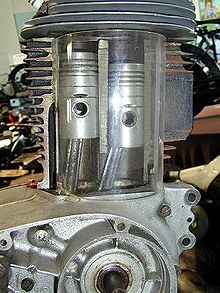and that my friend is called a "split-single" or "Twingle" engine it is a variant on the two-stroke engine with two cylinders sharing a single combustion chamber.
The following post is from https://en.wikipedia.org/wiki/Split-single
"Valvless engine of 1919, showing the operating cycle
The rationale of the split-single two-stroke is that, compared to a standard two-stroke single, it can give better exhaust scavenging while minimizing the loss of unburnt fresh fuel/air charge through the exhaust port. As a consequence, a split-single engine can deliver better economy, and may run better at small throttle openings.
A disadvantage of the split-single is that, for only a marginal improvement over a standard two-stroke single, the "Twingle" has a heavier and costlier engine. Since a manufacturer could produce a standard twin-cylinder two-stroke at an equivalent cost to a Twingle, it was perhaps inevitable that the latter should become extinct.
There have been "single" (i.e. twin-bore) and "twin" (i.e. four-bore) models. Unusually for a motorcycle engine, some Twingles have the carburetor mounted on the front of the engine, beneath the exhaust.
The first split-single engine was patented in 1912 by Italian engineer Adalberto Garelli. His company, Garelli Motorcycles, produced a 346 cc version for use in motorcycles for road use and for racing. Production continued until 1926, by which time Garelli was increasingly concentrating on the military market. Garelli motorcycles remained in business until the late 1990s, but they did not further develop or produce these engines.
Trojan (invented 1913)The Trojan two-stroke, as used from 1913 in the Trojan car in the UK. The "fore-and-aft" layout of the cylinders means that the V-shaped connecting rod has to flex slightly with each revolution.Unlike the German/Austrian motorcycle engines, this engine was water-cooled.
Puch 1923-1970 Sears marketed considerable numbers of the Puch SGS split-single fitted with both these innovations as the "Allstate 250" or "Twingle" in the US(I had one, it was an oil burning, sparkplug fouling SOB).
DKW 1931-1939, In 1931 split-single engines produced by Ing Zoller were used in motorcycle racing and helped DKW dominate smaller motorcycle racing classes between the wars.
Duray Indiananpolis 500 In 1932 the Mallory Special car driven at Indianapolis by Duray used a Duray 16-cylinder two-stroke using a split-single configuration
Monaco-Trossi 1935 the Monaco-Trossi Formula One car was built with a 16-cylinder radial engine using a split-single configuration
TWN 1946-1957 German TWN motorcycle company (originally part of Triumph Motorcycles in the UK) experimented with split-singles in 1939 and started producing two models when production resumed in 1946.
https://en.wikipedia.org/wiki/Split-single
Post WWII arrangement, carburetor to the front under the exhaust (neither visible). Transfer port visible at back. One connecting rod 'piggy-backed' on another.












 Reply With Quote
Reply With Quote